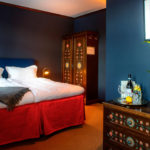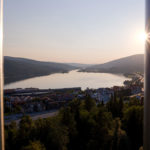Downhill skiing during Åre Week, 1922.
Photo: Nils Thomasson/Jamtli photo archives
The road to a World Championship
Åre is no stranger to the world of arranging world championships. In fact, the 2019 FIS Alpine World Championships will be its third time hosting and organising to exciting world-class events. Let’s rewind history back a few years and take a look at the story that paved the way for Åre as the ski resort it is today.
So it begins…
Åre begins to grow as a tourist resort in the late 19th century. It’s the clean air and high altitude that attracts the so-called “air guests”. The railway’s built, Åre Tourist Office is formed and Kristina Hansson opens the first hotel (Hotell Åreskutan). The funicular, Bergbanan, is in place as the first transport up to the mountains and The Grand Hotell opens their gates.
In 1919, the very first downhill races, Årebragden, are held on a 5,200-meter-long hill. At the beginning of the 20th century, Åre Slalomklubb is formed and the first tow lift is to be in place. Åre is now taking its first step towards becoming an international ski resort.
1954
The village is ready to host the Alpine World Championships for the first time, and what a World Championship it is! The world’s greatest champions in the Downhill, Giant Slalom, Slalom and Combination. Sarah Thomasson from Åre and Stig Sollander from Frösön both take home the bronze medal for Sweden. The championship star is the Norwegian Earl Stein Eriksen who climbed the podium three times.
Åre arranges its first World Cup in 1969, the first of many in the coming years. Åre Slalomklubb and Åre will have arranged over 100 successful world cup competitions over the following years.
Worth mentioning is the World Cup 1977, when Ingemar Stenmark himself draws 29,000 visitors to Åre to see the son of Tärnaby win on home turf. The last in recent memory is the 2018 FIS Alpine World Ski Championships where the international stars Lindsey Vonn, Marcel Hirscher, Frida Hansdotter, Sofia Goggia and Kjetil Jansrud competed.
In 1976 Åre Kabinbana, the cable car, opens. The snow cannons start up, the first lift, Olympialiften in Björnen is being built, and the classic Downhill, Störtloppet, is being prepared. In the 21st century, the ski area is expanding with new modern lifts, Holiday Club has it’s grand opening and a new railway station is built.
2007
2007 is the time for Åre to host the 39th Alpine World Cup. Over 100,000 pepped spectators are here during the championship. It’s a real nail biter to see the Swedish National Team bring home all seven medals. Ready for the starry sky, the great Anja Pärsson shines with her three gold and one bronze medals. Maria Pietilä-Holmner takes the World Cup silver and Patrik Järbyn a bronze in the Downhill. In addition, we win silver in the team competition.
The World Cup in 2007 leaves footprints in both the ski systems and the village when a new women’s downhill is created.The commercial areas double and a 130-meter tunnel replaces the former 30-meter-long bridge across the highway E14 that was previously the lower part of the Downhill, Störtloppet. 2013 is one of the largest lift investments ever in Åre’s history with three new chairlifts in place: Sadellexpressen, Fjällgårdsexpressen and Tegeliften.
2019
So, once again have the great honour of turning Åre into a World Cup Arena. Mark your calendar…February 5-17 is time for the World Cup 2019!











